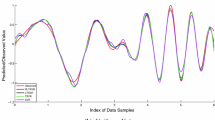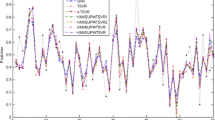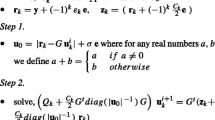Abstract
This paper proposes a novel \(l_1\)-norm loss based twin support vector regression (\(l_1\)-TSVR) model. The bound functions in this \(l_1\)-TSVR are optimized by simultaneously minimizing the \(l_1\)-norm based fitting and one-side \(\epsilon\)-insensitive losses, which results in different dual problems compared with twin support vector regression (TSVR) and \(\epsilon\)-TSVR. The main advantages of this \(l_1\)-TSVR are: First, it does not need to inverse any kernel matrix in dual problems, indicating that it not only can be optimized efficiently, but also has partly sparse bound functions. Second, it has a perfect and practical geometric interpretation. In the spirit of its geometric interpretation, this paper further presents a nearest-points based \(l_1\)-TSVR (NP-\(l_1\)-TSVR), in which bound functions are constructed by finding the nearest points between the reduced convex/affine hulls of training data and its shifted sets, respectively. Computational results obtained on a number of synthetic and real-world benchmark datasets clearly illustrate the superiority of the proposed \(l_1\)-TSVR and NP-\(l_1\)-TSVR as comparable generalization performance is achieved in accordance with the other SVR-type algorithms.





Similar content being viewed by others
Notes
Available at http://archive.ics.uci.edu/ml/.
References
Balasundaram S, Gupta D (2014) Training Lagrangian twin support vector regression via unconstrained convex minimization. Knowl Based Syst 59:85–96
Bates DM, Watts DG (1988) Nonlinear regression analysis and its applications. Wiley, New York
Bi J, Bennett KP (2003) A geometric approachto support vector regression. Neurocomputing 55:79–108
Cevikalp H, Triggs B, Yavuz HS, Küçük Y, Küçük M, Barkana A (2010) Large margin classifiers based on affine hulls. Neurocomputing 73(16–18):3160–3168
Chen J, Hu Q, Xue X, Ha M, Ma L (2017) Support function machine for set-based classification with application to water quality evaluation. Inf Sci 388–389:48–61
Crisp DJ, Burges CJC (2000) A geometric interpretation of \(\nu\)-SVM classifiers. In: Solla S, Leen T, Muller K-R (eds), Advances in neural information processing systems, pp. 244–250
Eubank RL (1999) Nonparametric regression and spline smoothing, statistics: textbooks and monographs, vol 157, 2nd edn. Marcel Dekker, New York
Gao S, Ye Q, Ye N (2011) 1-Norm least squares twin support vector machines. Neurocomputing 74:3590–3597
Ghorai S, Mukherjee A, Dutta PK (2009) Nonparallel plane proximal classifier. Signal Process 89(4):510–522
Hao P-Y (2009) Interval regression analysis using support vector networks. Fuzzy Sets Syst 160(17):2466–2485
Hao P-Y (2010) New support vector algorithms with parameteric insensitive /margin model. Neural Netw 23(1):60–73
Hsu CW, Lin CJ (2002) A comparison of methods for multiclass support vector machines. IEEE Trans Neural Netw 13:415–425
Jayadeva R, Khemchandani R, Chandra S (2007) Twin support vector machines for pattern classification. IEEE Trans Pattern Anal Mach Intell 29(5):905–910
Khemchandani R, Goyal K, Chandra S (2016) TWSVR: regression via twin support vector machine. Neural Netw 74:14–21
Khemchandani R, Saigal P, Chandra S (2016) Improvements on \(\nu\)-twin support vector machine. Neural Netw 79:97–107
Kohavi R (1995) A study of cross-validation and bootstrap for accuracy estimation and model selection. In: Proceedings of the 14th international joint conference on A.I., no. 2, Canada
Lee W, Jun CH, Lee JS (2017) Instance categorization by support vector machines to adjust weights in AdaBoost for imbalanced data classification. Inf Sci 381:92–103
López J, Barbero Á, Dorronsoro JR (2011) Clipping algorithms for solving the nearest point problem over reduced convex hulls. Pattern Recognit 44(3):607–614
Mangasarian OL (1994) Nonlinear programming. SIAM, Philadelphia
Mavroforakis ME, Theodoridis S (2006) A geometric approach to support vector machine (SVM) classification. IEEE Trans Neural Netw 17(3):671–682
Mercer J (1909) Functions of positive and negative type and the connection with the theory of integal equations. Philos Trans R Soc Lond Ser A 209:415–446
Parastalooi N, Amiri A, Aliheidari P (2016) Modified twin support vector regression. Neurocomputing 211(26):84–97
Peng X (2010) A \(\nu\)-twin support vector machine (\(\nu\)-TSVM) classifier and its geometric approaches. Inf Sci 180:3863–3875
Peng X (2010) TSVR: an efficient twin support vector machine for regression. Neural Netw 23(3):365–372
Peng X (2010) Primal twin support vector regression and its sparse approximation. Neurocomputing 73(16–18):2846–2858
Peng X (2011) TPMSVM: a novel twin parametric-margin support vector machine for pattern recognition. Pattern Recognit 44(10–11):2678–2692
Peng X (2012) Efficient twin parametric insensitive support vector regression model. Neurocomputing 79:26–38
Peng X, Wang Y (2012) Geometric algorithms to large margin classifier based on affine hulls. IEEE Trans Neural Netw 23(2):236–246
Peng X, Xu D, Kong L, Chen D (2016) \(L_1\)-norm loss based twin support vector machine for data recognition. Inf Sci 340C341:86–103
Peng X, Xu D, Shen J (2014) A twin projection support vector machine for data regression. Neurocomputing 138:131–141
Shao Y, Zhang C, Wang X, Deng N (2011) Improvements on twin support vector machines. IEEE Trans Neural Netw 22(6):962–968
Singh M, Chadha J, Ahuja P, Jayadeva R, Chandra S (2011) Reduced twin support vector regression. Neurocomputing 74:1474–1477
Shao Y, Zhang C, Yang Z, Jing L, Deng N (2013) An \(\epsilon\)-twin support vector machine for regression. Neural Comput Appl 23(1):175–185
Shevade SK, Keerthi SS, Bhattacharyya C, Murthy KRK (2000) Improvements to the SMO algorithm for SVM regression. IEEE Trans Neural Netw 11(5):1188–1193
Staudte RG, Sheather SJ (1990) Robust estimation and testing: Wiley series in probability and mathematical statistics. Wiley, New York
Tanveer M, Shubham K, Aldhaifallah M, Ho SS (2016) An efficient regularized K-nearest neighbor based weighted twin support vector regression. Knowl Based Syst 94:70–87
Tao Q, Wu G, Wang J (2008) A general soft method for learning SVM classifiers with \(L_1\)-norm penalty. Pattern Recognit 41(3):939–948
Vapnik VN (1995) The natural of statistical learning theory. Springer, New York
Vapnik VN (1998) Statistical learning theory. Wiley, New York
Weisberg S (1985) Applied linear regression, 2nd edn. Wiley, New York
Xu Y, Yang Z, Pan X (2017) A novel twin support-vector machine with pinball loss. IEEE Trans Neural Netw Learn Syst 28(2):359–370
Yang Z, Hua X, Shao Y, Ye Y (2016) A novel parametric-insensitive nonparallel support vector machine for regression. Neurocomputing 171:649–663
Ye Y, Bai L, Hua X, Shao Y, Wang Z, Deng N (2016) Weighted Lagrange \(\varepsilon\)-twin support vector regression. Neurocomputing 197:53–68
Zhao Y, Zhao J, Zhao M (2013) Twin least squares support vector regression. Neurocomputing 118:225–236
Author information
Authors and Affiliations
Corresponding author
Ethics declarations
Conflict of interest
We declare that we have not any conflict with other people or organizations that can inappropriately influence our work.
Additional information
Publisher’s Note
Springer Nature remains neutral with regard to jurisdictional claims in published maps and institutional affiliations.
Rights and permissions
About this article
Cite this article
Peng, X., Chen, D. An \(l_1\)-norm loss based twin support vector regression and its geometric extension. Int. J. Mach. Learn. & Cyber. 10, 2573–2588 (2019). https://doi.org/10.1007/s13042-018-0892-8
Received:
Accepted:
Published:
Issue Date:
DOI: https://doi.org/10.1007/s13042-018-0892-8




